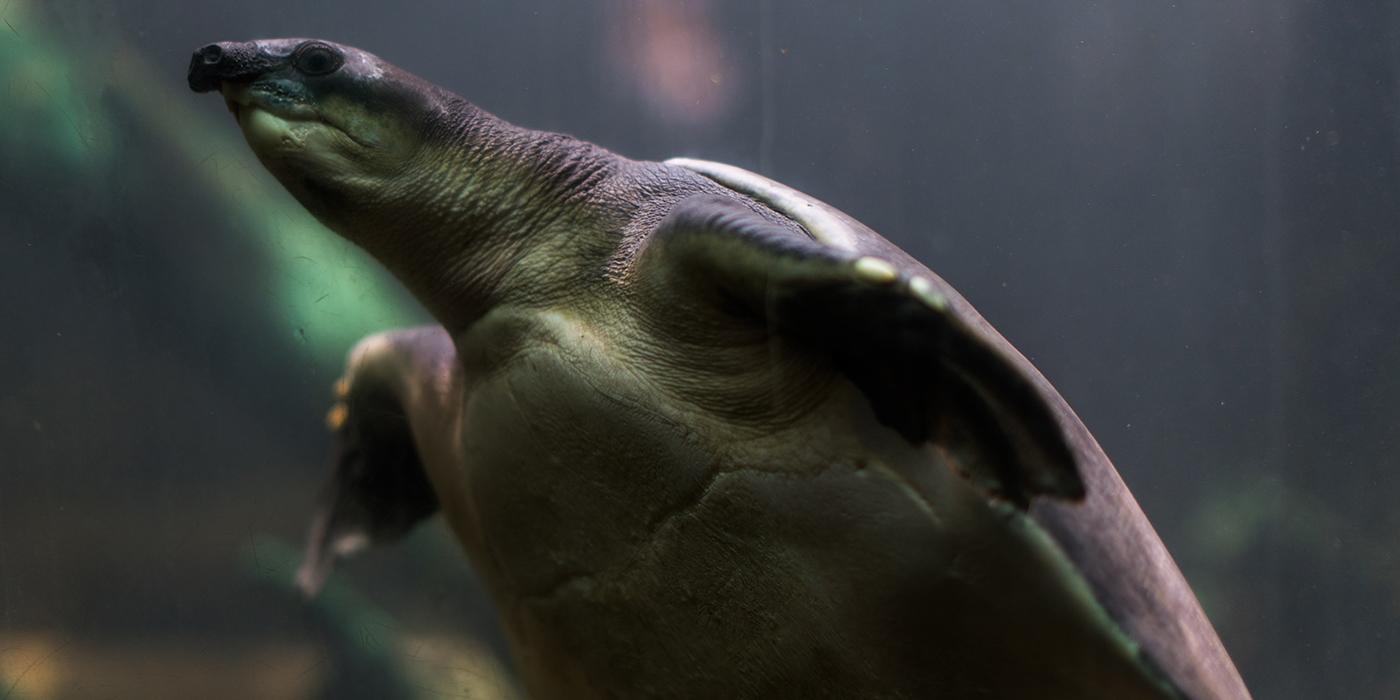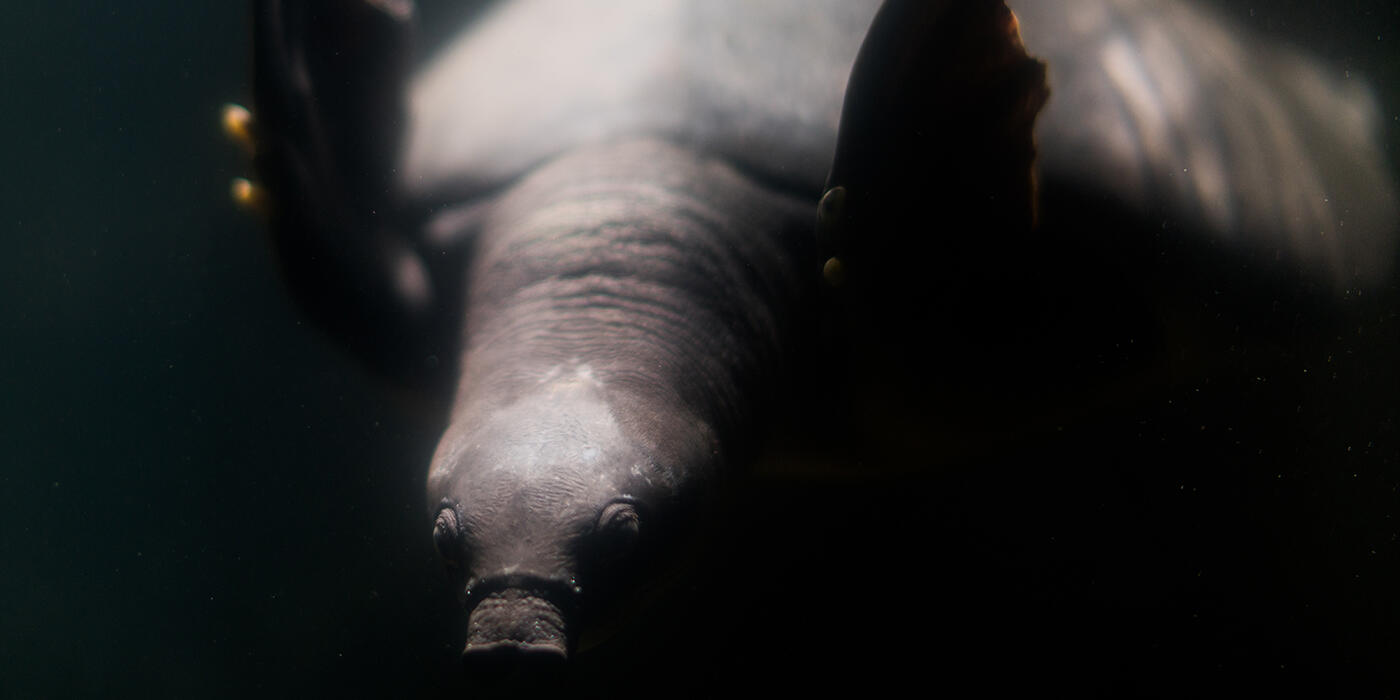Physical Description
Fly River turtles have gray bodies with white undersides that are somewhat transparent in juveniles. Similar to soft-shelled turtles, leathery skin covers their streamlined carapace and plastron (upper and lower shell, respectively). Their flipper-shaped forelimbs and webbed hind legs facilitate a swimming motion similar to that of sea turtles.
To escape predators, such as crocodiles, these turtles use their strong forelegs to generate a powerful, forward motion. Their hind legs, along with a flap of skin that is connected to the hind legs and tail, are used as a rudder. The combined effect allows them to swiftly maneuver out of harm’s way.
The Fly River turtle is sometimes called the pig-nosed turtle, because its unique head has a large, fleshy nose. This snout allows the turtle to breathe at the surface of the water while the rest of its body remains submerged, preventing it from being exposed to potential predators. The turtle's throat also has papillae, which absorb oxygen in the water.
In addition to its respiratory function, the snout also acts as a sensory organ, aiding the Fly River turtle's search for food in the coastal, murky waters it inhabits. Strong jaws with muscular attachments at the back of the skull give this turtle a strong bite, and claws on the forelimbs help it tear food apart.
The lighter underside of the turtle's shell offers camouflage within its aquatic environment. An animal swimming underneath the turtle would have difficulty discerning the white coloration of its plastron from the reflections of clouds, trees and vegetation at the surface of the water.
Size
Native Habitat
Fly River turtles are named for a river they inhabit in Papua New Guinea but are also found elsewhere, including lowland Papua New Guinea, northern Australia and southern Indonesia. They inhabit warm tropical rivers, streams, lakes and lagoons with soft bottoms and slow currents, and can be found in water up to 7 meters deep.
This species is predominantly aquatic, leaving the water only to nest. It spends most of its time in fresh water but will venture into brackish water, such as estuaries and river deltas.
Lifespan
Communication
Food/Eating Habits
Pig-nosed turtles are omnivores, but most of their wild diet is derived from plant material. They can be seen in coastal waters where overhanging fruits and nuts fall into the water. They also feed on the leaves, stems, roots and seeds of aquatic plants and will supplement their diet with small prey, such as snails, insects, shrimp and small fish.
New hatchlings survive on yolk from their eggs, and then start hunting small prey, such as insects and snails, until they are large enough to leave their nests and enter the water.
At the Smithsonian's National Zoo, Fly River turtles eat fruit, worms, shrimp, fish and pellets.
Reproduction and Development
Both males and females take a long time to reach sexual maturity at about 14-15 years old. Mating and nesting occurs during the dry season, which tends to be from July to November in Australia and September to February in Papua New Guinea. Females may lay up to two clutches of four to 39 eggs a year. However, they only mate every two years.
When choosing a nesting site, Fly River turtles tend to avoid areas of low elevation or with submerged vegetation, likely due to the risk of flooding. Each female turtle digs a shallow hole in the sand or mud in which to lay their eggs. The eggs incubate for 64 to 107 days. A hatchling's sex is determined by temperature, with more females produced at higher temperatures and more males at lower temperatures.
Young turtles can delay hatching for up to 50 days while they wait for the start of the wet season. Hatching coincides with the first rains of the season, which will flood the nest. The reduced level of oxygen in the nest triggers hatching.
Conservation Efforts
In Indonesia and Papua New Guinea, indigenous people harvest the eggs of Fly River turtles and capture the animals, either to sell them or for their meat. Aside from local use of Fly River turtles, this animal is widely captured for use in the international pet trade.
Technological advancements, such as outboards, have made hunting turtles easier. In addition, an increase in commercial activity, such as logging, mining and fishing, is bringing human populations into closer contact with these turtles. The combined effect of these various trends has led to a noticeable decrease in the wild population of Fly River turtles.
In Australia, the biggest threat to this species is habitat loss and degradation. Agricultural practices, such as the extraction of water for irrigation and pastoral activities, reduces the flow of water and changes the siltation of rivers. Fly River turtles are restricted to river channels and cannot move between river systems, so when the channels they inhabit are affected, the population of Fly River turtles in that area cannot easily recover.
Among the more prominent threats is the introduction of water buffalo and other livestock. Feral buffalo trample over nesting sites, eggs and hatchlings. They also graze on the water vegetation that these turtles eat.
As the last member of the Carettochelyidae family, the Fly River turtle is of particular importance and could serve as a flagship species. They are protected in Australia in the Kakadu National Park. Exportation of Fly River turtles has been banned. However, it is not well enforced in Indonesia and Papua New Guinea, so an illegal marker persists.
Help this Species
Reduce, reuse and recycle — in that order! Cut back on single-use goods, and find creative ways to reuse products at the end of their life cycle. Choose recycling over trash when possible.
Choose your pets wisely, and do your research before bringing an animal home. Exotic animals don’t always make great pets. Many require special care and live for a long time. Tropical reptiles and small mammals are often traded internationally and may be victims of the illegal pet trade. Never release animals that have been kept as pets into the wild.
Share the story of this animal with others. Simply raising awareness about this species can contribute to its overall protection.
Smithsonian's National Zoo and Conservation Biology Institute. (n.d.). Fly River turtle. Retrieved December 1, 2025, from https://nationalzoo.si.edu/animals/fly-river-turtle
Animal News

Giant Panda Qing Bao Gets a Checkup ›

7 Spooktacular Animal Facts for Halloween ›





